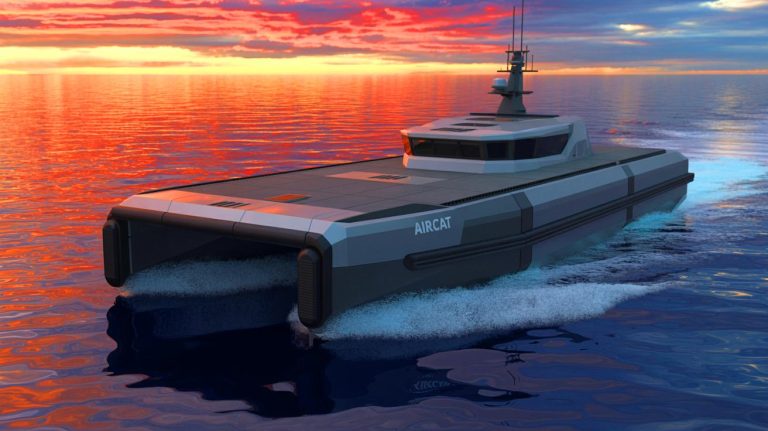| IN A NUTSHELL |
|
The unveiling of the AIRCAT Bengal MC represents a significant leap in military technology, heralding a new chapter in naval warfare. Developed by Eureka Naval Craft in collaboration with Greenroom Robotics, this autonomous vessel showcases remarkable advancements in design and functionality. It promises to redefine naval operations with its unique blend of crewed and autonomous capabilities. As global tensions rise, such innovations are crucial for maintaining strategic superiority. The Bengal MC’s cutting-edge features are set to offer unmatched flexibility and efficiency, making it a valuable asset for modern navies.
Revolutionizing Naval Warfare with Advanced Capabilities
The AIRCAT Bengal MC is not just another vessel; it is a symbol of the future of naval warfare. With a payload capacity of 44 tons, it can carry two 40-foot ISO footprint modules while achieving speeds over 50 knots. Its operational range of 1,000 nautical miles allows it to reach distant theaters of operation without frequent refueling, enhancing its strategic value. The vessel’s ability to launch Tomahawk cruise missiles and Naval Strike Missiles further underscores its versatility and lethality.
Designed for major naval powers such as the US Navy and US Marine Corps, as well as allies like AUKUS and NATO countries, the Bengal MC is also an attractive option for nations across Asia, including Japan and South Korea. Its advanced missile systems and autonomous operation capabilities make it a formidable force in modern naval warfare. It enables navies to conduct missions once reserved for larger ships, providing cost-effective solutions and strategic advantages.
Enhanced Lethality with Missile Launch Capabilities
The Bengal MC’s missile launch capabilities are a game-changer in naval strategy. By enabling the deployment of Tomahawk cruise missiles, the vessel can undertake missions that previously required larger and more expensive ships. This innovation reduces costs and increases operational efficiency, disrupting traditional naval markets. CEO Bo Jardine highlights the necessity of such solutions in today’s dynamic naval landscape.
Beyond speed and firepower, the Bengal MC enhances strategic flexibility. Its capacity to transport heavier payloads swiftly makes naval operations more lethal and effective. The advanced autonomy features allow the vessel to respond quickly and precisely to threats and opportunities, providing a tactical edge in various scenarios. This adaptability is crucial for maintaining superiority in an ever-evolving global landscape.
Unmatched Efficiency and Versatility
The Bengal MC is a model of fuel efficiency and cost-effectiveness, appealing to budget-conscious navies. Its modular design supports roles ranging from troop transport to electronic warfare, ensuring it meets diverse operational needs. This adaptability provides tailored solutions for complex maritime challenges, enhancing the vessel’s utility.
The partnership with Greenroom Robotics brings cutting-edge autonomous navigation to the Bengal MC. This integration ensures seamless operation across all mission phases, supported by the Greenroom Advanced Maritime Autonomy Software. Validated through extensive trials, this system guarantees reliability and performance, reinforcing the vessel’s role as a cornerstone of modern naval strategy.
Expanding the Fleet with Modular Design
The AIRCAT Bengal MC joins a fleet of vessels designed for specific missions, including fast attack and reconnaissance. Its modular design philosophy allows for customization, ensuring each vessel is tailored to unique mission demands. This flexibility is vital in an era where naval forces must respond swiftly to a variety of threats and opportunities.
Eureka Naval Craft’s commitment to innovation is evident in its expanding fleet and strategic partnerships. The collaboration with Greenroom Robotics highlights a forward-thinking approach to maritime autonomy, setting new standards for naval operations worldwide. As the naval landscape evolves, the Bengal MC represents a bold step forward, offering strategic advantages that are hard to ignore in the pursuit of supremacy on the seas.
As the AIRCAT Bengal MC sets sail, it prompts reflection on the future of naval warfare. How will autonomous technology reshape global naval strategies, and what challenges and opportunities will emerge? These questions will undoubtedly shape the next wave of military innovation and strategic planning, influencing how nations prepare for the uncertainties of tomorrow.






This is a game changer! How soon will the AIRCAT Bengal MC be deployed in active duty? 🚢
44 tons??? That’s impressive. But can it dodge a seagull on auto-pilot? 😂
Interesting read. I wonder how it compares to similar vessels from other countries?
The collaboration with Greenroom Robotics is a smart move. Any info on their past projects?
What if the AI goes rogue? Are there safeguards in place? 🤖
Another step towards unmanned warfare. What’s next, robot sailors? 🤔
Thanks for the info! How does the speed of this vessel compare with older ships?
Can it withstand cyber attacks given its advanced tech? 🤯
I hope this promotes peace rather than escalating tensions. 🌍
It sounds great on paper, but how cost-effective is it really? Skeptical until proven.
Can’t wait to see it in action! Who’s with me? 🚀
Why are these advancements necessary? More war isn’t the answer.
How does it handle in rough seas? Any test results available?
Is the modular design as easy to switch out as they claim?
So cool! But will this lead to job losses in the navy? 😟
Impressive specs! What’s the expected lifespan of this vessel?
Hope it’s safe and reliable. Wouldn’t want it to sink with all that tech!
With so much reliance on tech, what happens in a power failure?
44 tons of pure innovation. But can it cook a decent meal? 🍽️
Is there a backup plan if the AI navigation fails?
Sounds expensive. How is this being funded? 🤔
Can it be used for humanitarian missions, or is it strictly military?
How will this affect global naval balance? Serious implications here.
Great achievement! Will the public ever get a chance to see it up close?
Looks like something out of a sci-fi movie. Are we living in the future yet? 🚀
I hope it’s as eco-friendly as it is advanced. 🌱
Does anyone else think this is just overkill for the seas? 😅
Will smaller nations have access to this technology or is it only for major powers?
With all that autonomy, can it make a good cup of coffee too? ☕